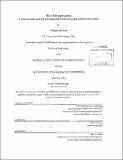The CAFE experiment : a joint seismic and MT investigation of the Cascadia subduction system
Author(s)
McGary, R. Shane
DownloadFull printable version (20.90Mb)
Alternative title
Joint seismic and MT investigation of the Cascadia subduction system
Other Contributors
Woods Hole Oceanographic Institution.
Advisor
Rob L. Evans.
Terms of use
Metadata
Show full item recordAbstract
In this thesis we present results from inversion of data using dense arrays of collocated seismic and magnetotelluric stations located in the Cascadia subduction zone region of central Washington. In the migrated seismic section, we clearly image the top of the slab and oceanic Moho, as well as a velocity increase corresponding to the eclogitization of the hydrated upper crust. A deeper velocity increase is interpreted as the eclogitization of metastable gabbros, assisted by fluids released from the dehydration of upper mantle chlorite. A low velocity feature interpreted as a fluid/melt phase is present above this transition. The serpentinized wedge and continental Moho are also imaged. The magnetotelluric image further constrains the fluid/melt features, showing a rising conductive feature that forms a column up to a conductor indicative of a magma chamber feeding Mt. Rainier. This feature also explains the disruption of the continental Moho found in the migrated image. Exploration of the assumption of smoothness implicit in the standard MT inversion provides tools that enable us to generate a more accurate MT model. This final MT model clearly demonstrates the link between slab derived fluids/melting and the Mt. Rainier magma chamber.
Description
Thesis (Ph. D. in Geophysics)--Joint Program in Marine Geology and Geophysics (Massachusetts Institute of Technology, Dept. of Earth, Atmospheric, and Planetary Sciences; and the Woods Hole Oceanographic Institution), 2013. Page 176 blank. Cataloged from PDF version of thesis. Includes bibliographical references.
Date issued
2013Department
Joint Program in Marine Geology and Geophysics; Woods Hole Oceanographic Institution; Massachusetts Institute of Technology. Department of Earth, Atmospheric, and Planetary SciencesPublisher
Massachusetts Institute of Technology
Keywords
Joint Program in Marine Geology and Geophysics., Earth, Atmospheric, and Planetary Sciences., Woods Hole Oceanographic Institution.